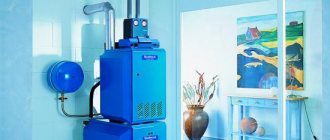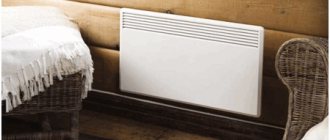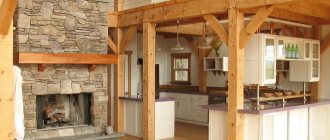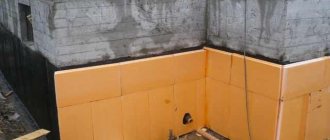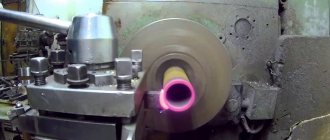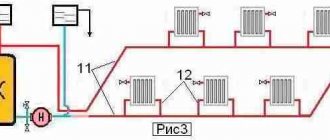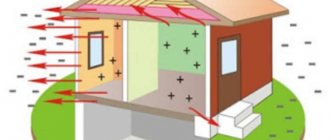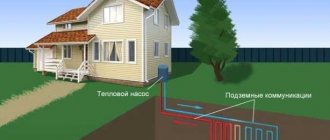
It would seem that quite recently people were happy with the invention of the washing machine, microwave oven and refrigerator, but all these devices managed to become so firmly established in our life that we can no longer imagine how we did without them before. Will the technological innovations offered now become the same in demand over time?
Technology is evolving at a rapid pace, and today there are a wide variety of devices on the market, including smart home systems that help their owners clean, cook and even relax.
More recently, we couldn't even dream of such devices - a smart bed that monitors sleep patterns, a smart toilet that heats the seat, and a smart toothbrush that notifies you when you press too hard on your gums. Many people do not even suspect the existence of the smart gadgets presented below, nevertheless, they can take their rightful place in our new homes.
What about a shower?
As the talented guy admits, so far there is no bathroom or restroom in the house. He did not conceive of a serious construction and did not expect that he did it so well. But, now the young man plans to fully equip his home. True, he is thinking about organizing a shower room on the street to take a shower among the trees.
John really created a unique project. He was able to understand all the intricacies of construction and modernize the building. It is worth paying tribute to the wonderful place in which he decided to start building. By the way, it's hard to believe that this is actually John's father's farm. So you can watch the farm from home.


Screenshot of the video from the Living Big In A Tiny House channel https://www.youtube.com/watch?v=GbzmlbWRo-0
And if you want to move to another place, you don't have to build the house again. It turns out the house is ready for transportation. This is another unusual feature of the building.
John is currently working on a project for a device that could be attached to a trailer and transported to his panoramic house. So far, he settled on 3D modeling, but considering that the guy was also starting to build a house, perhaps soon he will present something new and unusual.


Screenshot of the video from the Living Big In A Tiny House channel https://www.youtube.com/watch?v=GbzmlbWRo-0
What is inside
Upon identification, John enters a narrow tube with a staircase leading upstairs. Apparently, those who suffer from claustrophobia will have a hard time, but the view from the house is worth it.
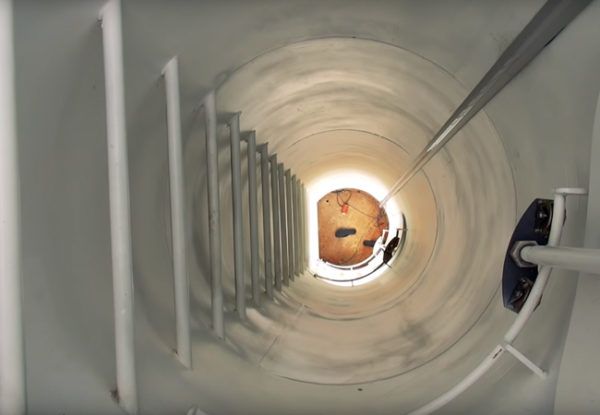

Screenshot of the video from the Living Big In A Tiny House channel https://www.youtube.com/watch?v=GbzmlbWRo-0
Inside you will find a modern interior and simply stunning views. Most of the dome of the building is made of glass, so it seems that sofas and other furniture are practically suspended in the air.
John says he just wanted to create a place to hang out and enjoy the nature that New Zealand is so famous for. Therefore, the man equipped the room with everything necessary to spend his leisure time here.
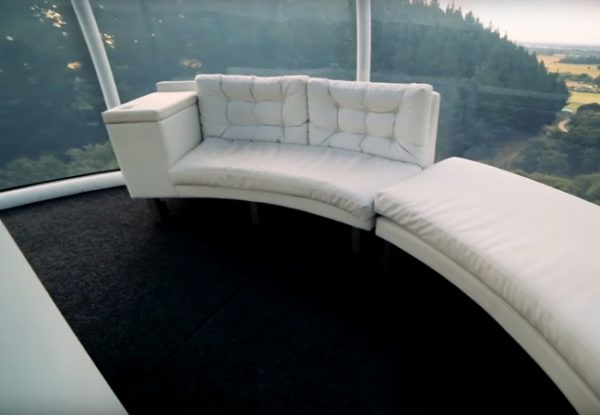

Screenshot of the video from the Living Big In A Tiny House channel https://www.youtube.com/watch?v=GbzmlbWRo-0
The building is equipped with the latest technology. Besides the scanner at the entrance, John has added many modern features. For example, the dome light can be turned on and off using a mobile phone.
The guy thought of everything for fun. For example, it is impossible to notice that there is a so-called beer dispenser (device for dispensing a foamy drink) in the armrest of the sofa. But even this is not the most interesting thing. A can of cold beer is automatically dispensed directly into the hand as soon as John says, "Beer, please."After that, a can of "cold" leaves automatically from the hole in the headrest.
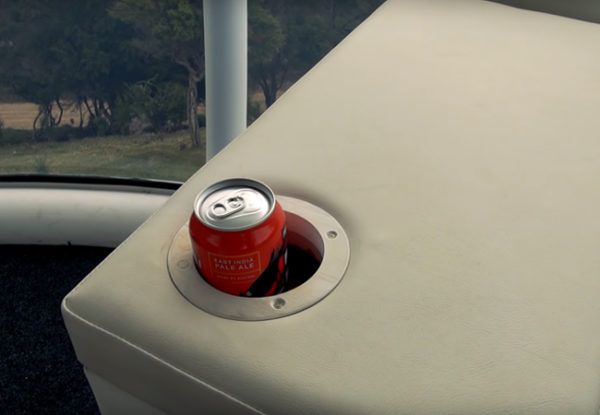

Screenshot of the video from the Living Big In A Tiny House channel https://www.youtube.com/watch?v=GbzmlbWRo-0
Everything in the house is optimized and controlled through the application in the phone. John can even control the power supplied from the solar panels. After the request, the young man listens carefully to the information about the amount of energy left and how many hours it will last. Remember the movies in which the captain of a spaceship asks the onboard computer for information? John does the same.
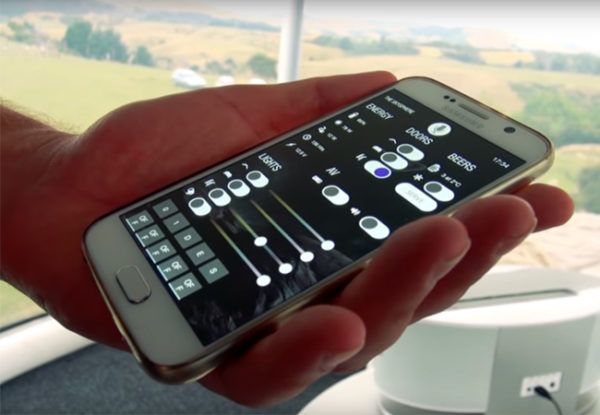

Screenshot of the video from the Living Big In A Tiny House channel https://www.youtube.com/watch?v=GbzmlbWRo-0
The young man says that today there are a large number of applications for mobile devices that help not only simplify life, but also significantly save on electricity. Of course, for this, modern devices are installed in the house that support such a control mode. For example, without getting up from the couch, John turns on the light, music, gets beer. And if someone comes to visit, John does not need to go down the stairs to open the door. He does it from his cell phone.
There is no TV in the house, but there is a projector that shows the image directly on the glass of one of the walls of the “tree house”.
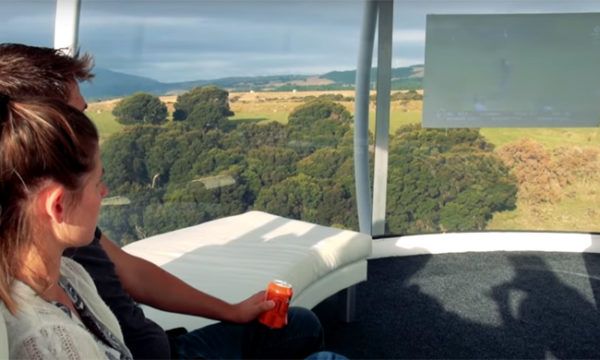

Screenshot of the video from the Living Big In A Tiny House channel https://www.youtube.com/watch?v=GbzmlbWRo-0
Of course, during the day you won't watch football especially, but in the evening you can enjoy movies and admire nature. John also thought of lighting in the house, which changes not only its intensity, but also its color. Therefore, you can arrange a romantic evening or a noisy party.
And that's not all. If John activates one of the modes, then the house starts to glow outside. At night, this building may well be mistaken for a UFO. But everything looks very impressive.


Screenshot of the video from the Living Big In A Tiny House channel https://www.youtube.com/watch?v=GbzmlbWRo-0
John spends enough time in the house, often stays at night. It also has everything you need for relaxation. For example, there is a bed next to one of the walls of a panoramic house. Under it there are compartments for things, so a young man does without a closet.


Screenshot of the video from the Living Big In A Tiny House channel https://www.youtube.com/watch?v=GbzmlbWRo-0
2.2.1. Robot vacuum cleaner for cleaning an apartment
Fig. 5. Robot vacuum cleaners
The system automatically detects the degree of pollution in the room and directs the required number of robots to each area.
Colombian student Adrian Perez Zapata developed an innovative concept for the home cleaning system. The device consists of a spherical mother platform (Fig. 5) and several dozen flying tiny robots connected to it. The cleaning process is fast enough. The system automatically detects the degree of pollution in the room and directs the required number of robots to each area. Each one is equipped with small propeller wings, a special sponge and a reservoir for water and cleaning agents. During the cleaning process, mini-robots pass a damp sponge over the surface and clean it at the base.
The mother platform not only controls the squad of robots, but also serves as a charging point for them. She herself is non-volatile and is charged using solar panels. The system is synchronized with the application in the smartphone, with which you can schedule cleaning and monitor the progress.
Pros and cons of foam concrete as a material for building houses
Foam concrete is similar to aerated concrete in its porous structure, but has closed pores. The blocks are made from cement and sand by adding water and a foaming agent to the mixture.
For the production of foam concrete, neither complex technology nor expensive equipment is required. This allows you to get a fairly budgetary material, but it also carries certain risks, making production attractive for small non-professional firms. The blocks made in artisanal conditions are of low quality.
Advantages of foam concrete:
- light weight;
- low thermal conductivity;
- ease of cutting;
- low hygroscopicity due to the closed pore system.
Cons of foam concrete:
- insufficient gas exchange (steam passes poorly, therefore a forced ventilation system is needed);
- does not lend itself to bending stress;
- subject to significant shrinkage, which leads to the formation of cracks.
Despite the existing drawbacks, this rather cheap material is often chosen for building a house. Also, with its help, they perform sound and thermal insulation of walls, roofs, floors, etc.
Aerated concrete as one of the best materials for building a house
From an aesthetic point of view, aerated concrete loses to ceramic blocks, but keeps heat much better. The thermal technical characteristics of a 30–40 cm thick aerated concrete wall will be similar to a wall built of several layers of bricks or ceramic blocks. Aerated concrete provides a good indoor climate.
Due to the numerous pores, the thermal conductivity of aerated concrete is three times less than that of a brick. The material is not subject to decay, does not deteriorate, accordingly, it has no restrictions on the service life.
Due to the low weight of the blocks, their transportation is simplified. The undoubted advantage of aerated concrete is the ease of installation - the blocks are easily cut with a hacksaw, the masonry does not need a lot of mortar or glue, due to the large dimensions of the elements, construction is progressing quickly. If you use glue for masonry, you can get thin seams, which improves thermal insulation. The surface of the blocks is very flat, and the wall of them requires minimal finishing.
Aerated concrete is environmentally friendly, as it is made from natural materials. In addition, it has high compressive strength, does not burn, is frost-resistant, provides good gas exchange in the room, comparable to the parameters of a wooden building.
Aerated concrete is produced in various densities (D), and this is its most important characteristic. If you decide to use blocks to build a house, it is important to understand what materials to use for the walls. The density of aerated concrete can be in the range of 350–1200 kg / m3 and is denoted by the letter D and the corresponding numerical value. Aerated concrete of the D500 – D900 brand is suitable for building a house. The standard block will have the following parameters: 20 x 25 x 60 cm, weight 18 kg. Moreover, its volume is equal to 20 bricks weighing about 80 kg. If you choose materials for building a house, it may be worth buying aerated concrete, because it has many advantages.
Necessary materials for the construction of a frame house
Building a house is possible from different materials, but it is worth mentioning separately frame buildings. The technology was developed abroad and came to Russia a long time ago, but with the improvement of materials it gained new popularity. Such buildings can be called in different ways - frame-panel, Canadian, sandwich-panel houses. They are based on a wooden frame, on which ready-made panels are attached, which are a base of wood, sheathed with plywood or boards on both sides, and the free space is laid with insulation (mineral wool, expanded polystyrene).
The popularity of frame houses is due to the speed of their construction, low cost and durability. All this is true only if quality materials are used and the technology is maintained.
Advantages of a frame house:
- Due to the use of high-quality heaters in the panels, the heat loss of the building will be minimal.
- The house is being built from ready-made standard panels, which greatly reduces the construction time.
- The house does not shrink, no mortars are used during construction, which means that they do not need time to dry. All this makes it possible to carry out finishing work immediately after the installation of the panels.
- The panels are not susceptible to moisture and pests, as they undergo special processing during manufacture.
- Low weight, giving low load on the foundation.
- Panels are a cheap material for building a home.
Disadvantages:
- the ability to ignite, like a tree;
- the use of standard elements does not allow diversifying the design of the house;
- adherence to construction technology is very important, since it will be much more expensive to correct mistakes later than in other types of houses;
- the strength of houses is reduced, which leads to the need for a careful calculation of the loads;
- not very good soundproofing.
The cheapness and speed of construction of frame houses cover all their disadvantages, therefore this technology is widely used in the construction of entire villages.
System advantages
Just as in our time, we adored a TV with a remote control, so today many citizens relate to indoor and outdoor equipment that is programmable and configured for any needs. Benefits of new smart home technologies:
- useful performance of various functions;
- a wide range of services;
- orderly, coordinated and interconnected work of all devices;
- refusal from the staff of servants and guards;
- saving resources in the absence of owners;
- maximum comfort and safety.
Modern material for building a house - porous ceramics
Ceramic blocks can be called an improved type of brick. They are also made of clay, and the increase in thermal insulation is achieved by two methods: by creating voids during molding and additional pores in the material, which are obtained due to the fact that the sawdust added to the clay initially burns out during firing.
Advantages of porous ceramics:
- low thermal conductivity;
- environmental friendliness;
- large block size (building speed increases);
- light weight (the load on the foundation is reduced).
Disadvantages:
- high cost;
- lower strength and bearing capacity when compared with solid ceramic bricks;
- fragility;
- increased hygroscopicity.
Manufacturers produce porous ceramic blocks with different characteristics. You can often find information that this material is not inferior in strength to solid brick and concrete of the M100 brand, it is suitable for the construction of load-bearing walls. But in practice, this is far from the case, the strength of ceramic blocks can be different, therefore, this parameter must be paid attention to when buying them.
The good thermal insulation properties of ceramic blocks, despite some drawbacks, made them popular in private construction, including premium ones.
